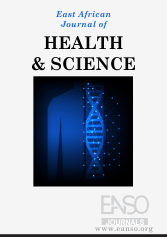Clinical Etiology and Histopathologic Correlation of Exfoliative Erythroderma at the Kenyatta National Hospital
Abstract
Background: Exfoliative erythroderma is a dermatologic emergency characterised by diffuse skin redness and scaling involving at least 70% body surface area. It is a clinical presentation that is usually indicative of an underlying primary process. Once a clinical diagnosis of exfoliative erythroderma is made, prompt supportive measures should be instituted while seeking to identify the underlying cause of this presentation. The correlation between clinical and histopathological diagnoses has not been determined for the Kenyan population. Purpose of the study: To assess the frequency of causes of exfoliative erythroderma and their histopathologic correlation at Kenyatta National Hospital. Methodology: This was an ambispective study conducted in Kenyatta National Hospital wards and clinics. All adult patients with exfoliative erythroderma who meet the study criteria will be included. A total sample size of 94 patients was included in the study. Descriptive analysis was done where demographic, clinical and histopathological factors were summarised using mean and standard deviation as well as median and interquartile range. A sensitivity analysis was performed to correlate clinical findings and histopathological findings. Results: The median age was 45 (interquartile range: 30 – 60 years, and 53% of them were male. Clinical causes of EE revealed that most of the patients with EE were due to psoriasis (38.3%), followed by malignancies (21.3%) and eczema (18.1%). Clinical findings revealed that the common causes of EE included dermatoses (57.45%), with psoriasis (24.2%) followed by eczema (18.1%). Malignancies (21.3%) were the second most common group and the commonest systemic disease, followed by drug reactions (12.7%). HIV was present in 7.5% of the cases. The findings showed that 63% (n =57) of the patients had a biopsy done, although the frequency was lower in the retrospective arm, 57% (n =42), compared to the prospective arm of the study, 88% (n =15). The findings from the histopathological findings revealed that 39.2% were malignancies, followed by psoriasis 25.5%) and immunobullous disease (17.7%). The sensitivity analysis revealed that immunobullous (100%) and malignancy (92.3%) had a high level of sensitivity as well as specificity, which was 97.7% and 92.6%, respectively, although eczema and psoriasis were least correlated with histopathological findings. Conclusion: Clinical findings were better correlated with malignancy and immunobullous findings with high sensitivity and specificity, although the other histopathology findings, such as psoriasis and eczema, were poorly correlated. Thus, there is a continued need to adopt a biopsy‐first protocol for all new presentations of EE to maximise diagnostic yield.
Downloads
References
Akhyani, M., Ghodsi, Z. S., Toosi, S., & Dabbaghian, H. (2005). Erythroderma: A clinical study of 97 cases. BMC Dermatology, 5, 5. https://doi.org/10.1186/1471-5945-5-5
Amrutha, J., Gurram, N. R. N., Pinjala, P., Katakam, B. K., & Thakur, R. S. (2021). A Clinico-Etiological Study of Erythroderma in Adults in a Tertiary Care Centre. Journal of Evolution of Medical and Dental Sciences, 10(37), 3213–3219. https://doi.org/10.14260/jemds/2021/653
Austad, S. S., & Athalye, L. (2025). Exfoliative Dermatitis. In StatPearls. StatPearls Publishing. http://www.ncbi.nlm.nih.gov/books/NBK554568/
Burden-Teh, E., Phillips, R. C., Thomas, K. S., Ratib, S., Grindlay, D., & Murphy, R. (2018). A systematic review of diagnostic criteria for psoriasis in adults and children: Evidence from studies with a primary aim to develop or validate diagnostic criteria. The British Journal of Dermatology, 178(5), 1035–1043. https://doi.org/10.1111/bjd.16104
César, A., Cruz, M., Mota, A., & Azevedo, F. (2016). Erythroderma. A clinical and etiological study of 103 patients. Journal of Dermatological Case Reports, 10(1), 1–9. https://doi.org/10.3315/jdcr.2016.1222
Deka, B., Gupta, B., & Saha, M. (2015). A CLINICO - PATHOLOGICAL STUDY OF ERYTHRODERMA IN A TERTIARY CARE CENTRE IN ASSAM, INDIA. Journal of Evolution of Medical and Dental Sciences, 4(70), 12133–12142. https://doi.org/10.14260/jemds/2015/1748
Di Prinzio, A., Torre, A. C., Cura, M. J., Puga, C., Bastard, D. P., & Mazzuoccolo, L. D. (2022). Las reacciones adversas a fármacos son la primera causa de eritrodermia. Estudio retrospectivo de 70 pacientes en un hospital universitario de Argentina. Actas Dermo-Sifiliográficas, 113(8), 765–772. https://doi.org/10.1016/j.ad.2022.03.009
El-Hamd, M. A., Ahmed, S. F. M., Ali, D. G. A., & Assaf, H. A.-E. (2022). Clinicopathological assessment of patients with erythroderma. Egyptian Journal of Dermatology and Venereology, 42(2), 81–91. https://doi.org/10.4103/ejdv.ejdv_32_21
Hoxha, S., Fida, M., & Vasili, E. (2020). Erythroderma: A Manifestation of Cutaneous and Systemic Diseases. EMJ Allergy & Immunology. https://doi.org/10.33590/emjallergyimmunol/19-00182
Jackow, C. M., Cather, J. C., Hearne, V., Asano, A. T., Musser, J. M., & Duvic, M. (1997). Association of Erythrodermic Cutaneous T-Cell Lymphoma, Superantigen-Positive Staphylococcus aureus, and Oligoclonal T-Cell Receptor Vβ Gene Expansion. Blood, 89(1), 32–40. https://doi.org/10.1182/blood.V89.1.32
Kliniec, K., Snopkowska, A., Łyko, M., & Jankowska-Konsur, A. (2024). Erythroderma: A Retrospective Study of 212 Patients Hospitalized in a Tertiary Center in Lower Silesia, Poland. Journal of Clinical Medicine, 13(3), 645. https://doi.org/10.3390/jcm13030645
Miyashiro, D., & Sanches, J. A. (2020). Erythroderma: A prospective study of 309 patients followed for 12 years in a tertiary center. Scientific Reports, 10(1), 9774. https://doi.org/10.1038/s41598-020-66040-7
Munyao, T. M., Abinya, N. A., Ndele, J., Kitili, P., Maimba, J., Kamuri, E. N., & Wanyika, H. W. (2008). Exfoliative erythroderma at Kenyatta National Hospital, Nairobi. East African Medical Journal, 84(12), 566–570. https://doi.org/10.4314/eamj.v84i12.9593
Svensson, A., Lindberg, M., Meding, B., Sundberg, K., & Stenberg, B. (2002). Self-reported hand eczema: Symptom-based reports do not increase the validity of diagnosis. The British Journal of Dermatology, 147(2), 281–284. https://doi.org/10.1046/j.1365-2133.2002.04799.x
Whiteman, D. C., Olsen, C. M., MacGregor, S., Law, M. H., Thompson, B., Dusingize, J. C., Green, A. C., Neale, R. E., Pandeya, N., & QSkin Study. (2022). The effect of screening on melanoma incidence and biopsy rates. The British Journal of Dermatology, 187(4), 515–522. https://doi.org/10.1111/bjd.21649
Copyright (c) 2025 Karen Waithera Wainaina, Priscilla Angwenyi, Beatrice Wangari Ndege

This work is licensed under a Creative Commons Attribution 4.0 International License.




























